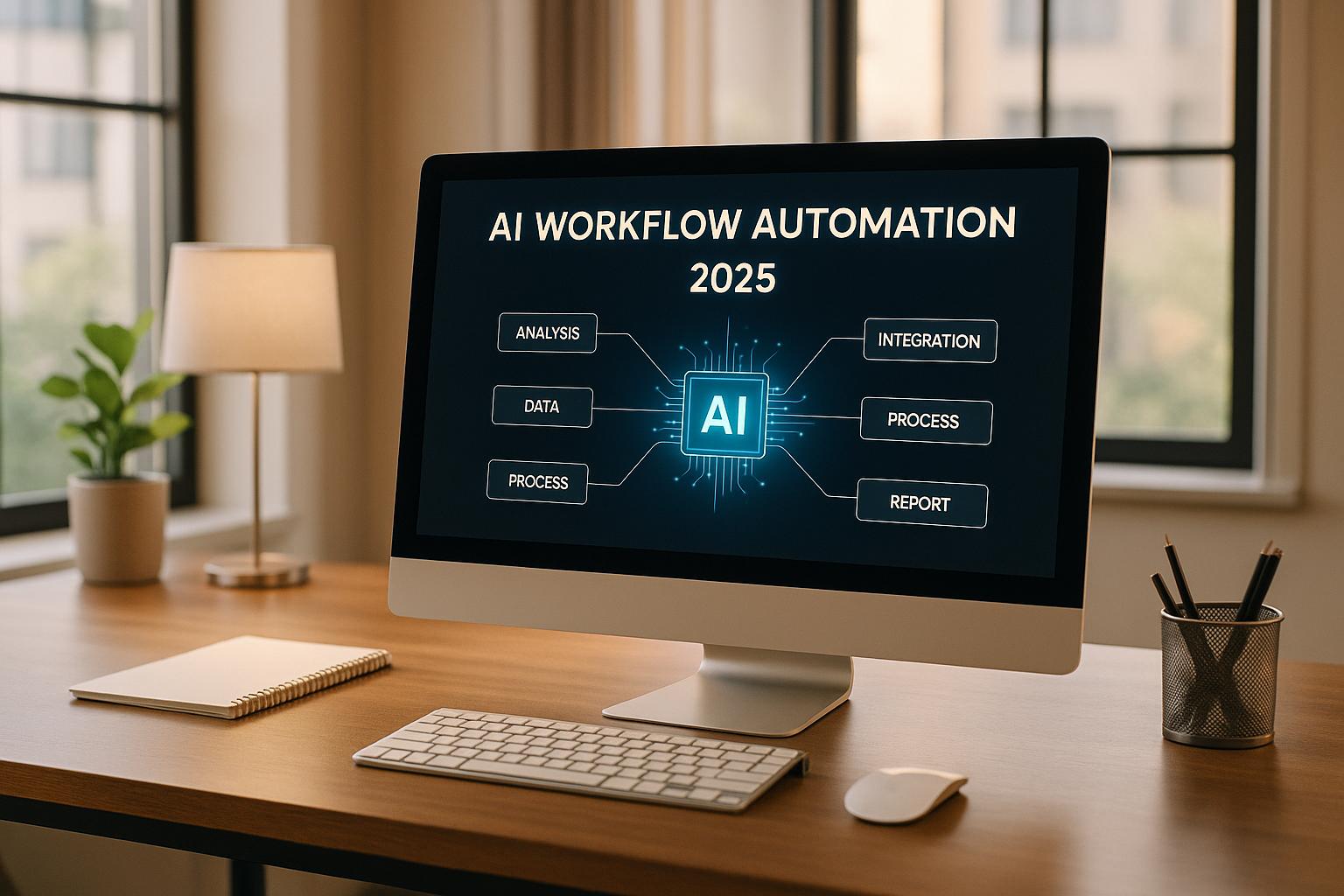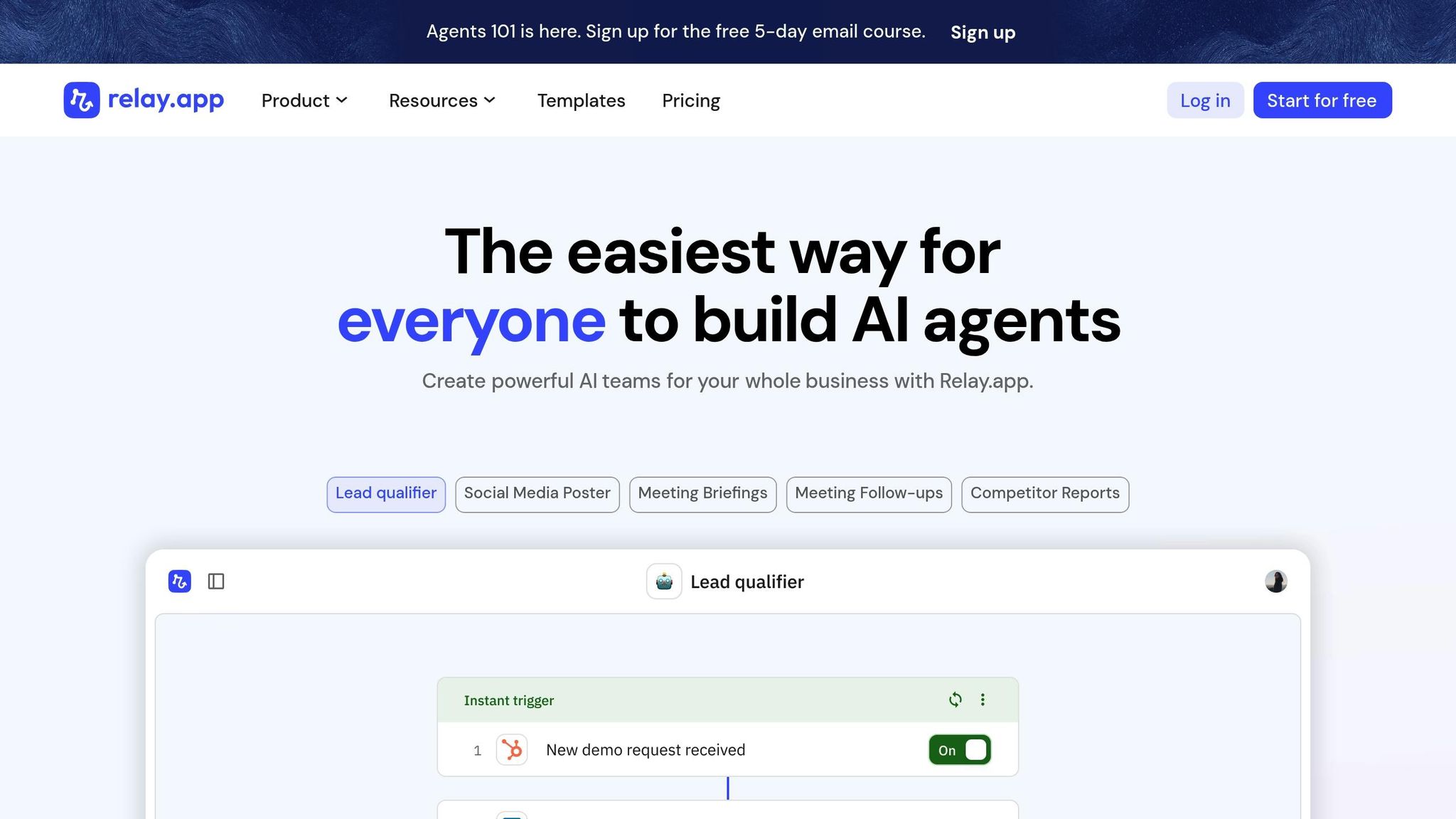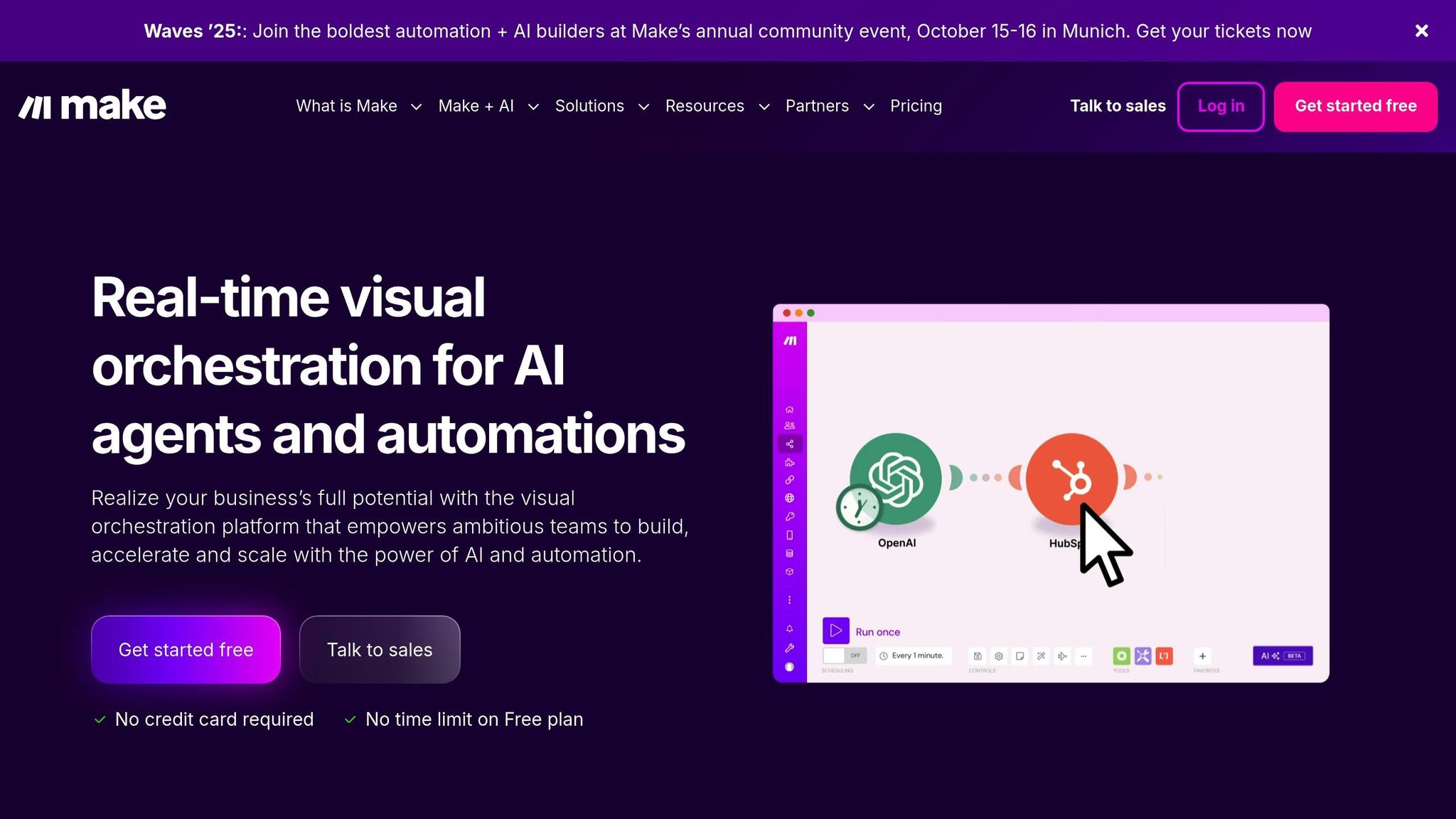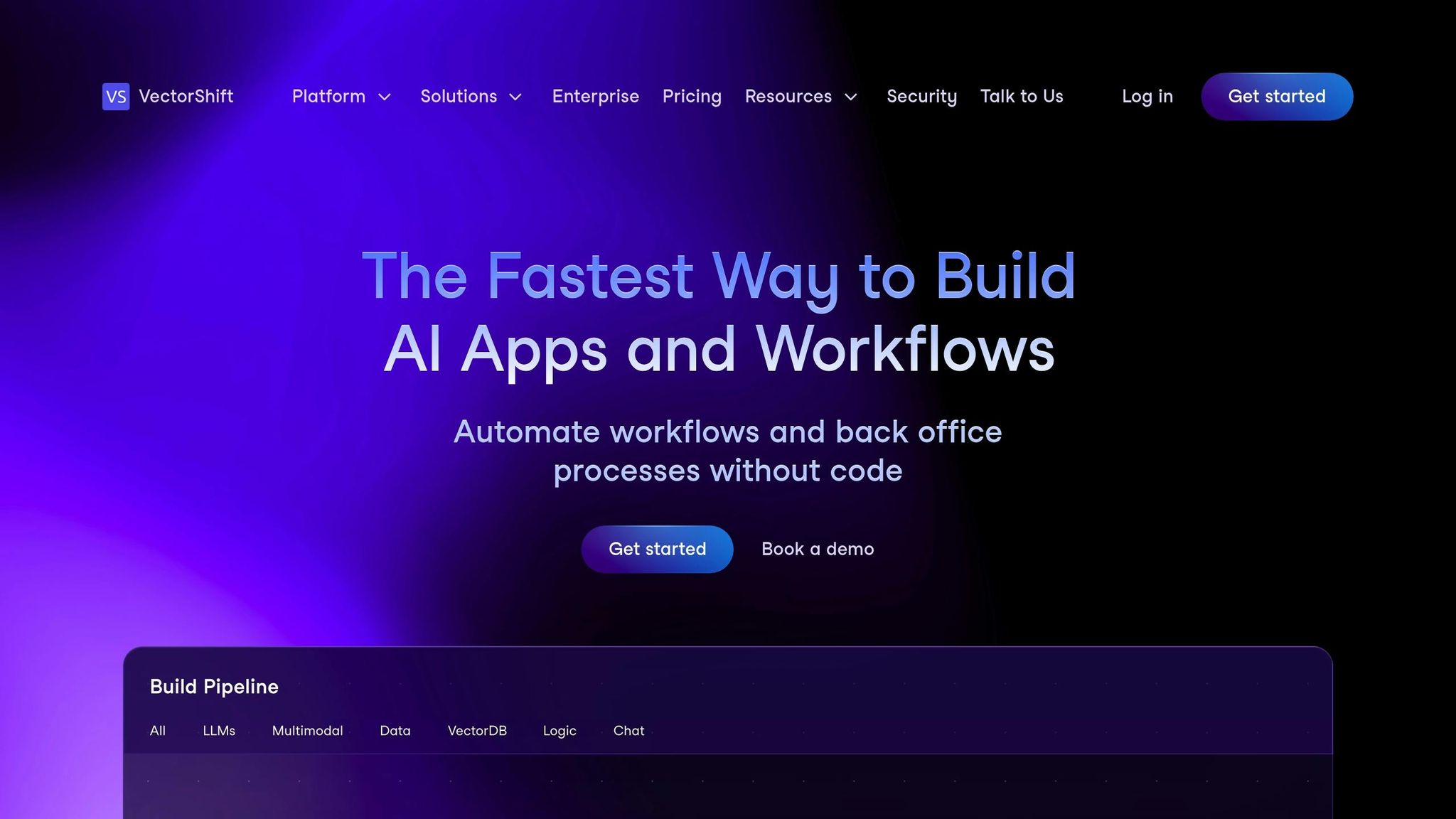
In 2025, rising operational expenses pushed U.S. businesses to adopt AI workflow automation platforms. These tools simplify processes, reduce inefficiencies, and deliver measurable cost savings. Five platforms stand out for their ability to help businesses save money while addressing key challenges like manual work and process bottlenecks:
These platforms cater to businesses of all sizes, offering options to streamline operations, enhance productivity, and achieve financial savings. Below, we’ll explore their features, pricing, and real-world benefits to help you choose the best fit for your needs.

Prompts.ai is a cutting-edge platform designed to streamline AI-driven workflows. By bringing together over 35 language models, including GPT-5, Claude, LLaMA, and Gemini, it offers a secure and unified interface tailored specifically for AI-powered business automation. With its robust capabilities, the platform simplifies even the most complex business processes.
Prompts.ai stands out for its ability to integrate seamlessly with a wide range of business systems. Supporting over 50 popular applications like Google Calendar, Slack, and HubSpot, it allows businesses to automate tasks across multiple platforms without the hassle of switching tools. Its visual workflow builder and trigger/action canvas make it accessible to users without technical expertise, enabling them to design AI-powered automations without writing a single line of code.
One of the platform's standout features is its clear and predictable pricing. Prompts.ai provides detailed analytics on resource usage and workflow execution, ensuring businesses have full visibility into their spending. Operating on a usage-based pricing model, plans start at approximately $49 per month for small teams. By using pay-as-you-go TOKN credits, costs are directly tied to actual usage. This approach has enabled some businesses to reduce operational expenses by as much as 40% within the first year.
Prompts.ai is built to support businesses at any stage of growth. Its cloud-based infrastructure is designed to handle high-throughput environments, large data sets, and increasing complexity. Whether you're a small team or a large enterprise, the platform makes it easy to scale by adding integrations, expanding workflows, or onboarding new users as your business grows.
Security is at the core of Prompts.ai’s design. The platform includes enterprise-grade features like role-based access control, audit logs, and advanced data privacy protections. It complies with industry standards such as SOC 2 and GDPR, making it a dependable choice for companies in highly regulated industries or those managing sensitive customer information. These security measures not only provide peace of mind but also complement its cost-saving capabilities.
Prompts.ai delivers tangible financial benefits by automating repetitive tasks and optimizing workflows. Features like AI-powered document processing, intelligent customer support, and automated data extraction significantly reduce manual labor and operational costs. Businesses using Prompts.ai have reported up to a threefold increase in productivity by integrating AI into everyday operations.
For example, a mid-sized marketing agency used Prompts.ai to automate client onboarding, email management, and reporting. This reduced their manual workload by 40% and saved them $25,000 annually. Additionally, advanced tools like prompt chaining and multi-agent orchestration eliminate the need for constant manual oversight. These real-world savings highlight Prompts.ai’s ability to deliver measurable financial results, making it a strong contender among leading platforms.

Lindy uses autonomous AI agents to streamline workflow automation across various business operations. Its agent-driven design allows businesses to create tailored AI assistants capable of managing intricate, multi-step tasks without requiring constant human supervision.
One of Lindy’s standout features is its "Autopilot" capability, which enables AI agents to operate their own cloud-based computers. This eliminates the constraints of traditional API integrations, allowing agents to interact with virtually any software or web-based platform a human user could access. The platform also includes Team Accounts, simplifying the sharing of AI agents across departments. This feature ensures smooth collaboration while still supporting customized workflows for individual teams. Additionally, Lindy’s integration capabilities are paired with a transparent pricing structure that adapts as your business grows.
Lindy provides a clear and flexible pricing model. Its usage-based pricing structure adjusts according to task complexity and volume, offering more predictable costs compared to traditional seat- or task-based models. The platform offers multiple pricing tiers to suit businesses of different sizes and needs:
| Plan | Monthly Cost | Credits Included | Best For |
|---|---|---|---|
| Free | $0 | 400 credits | Testing and small-scale automation |
| Pro | $49.99 | 5,000 credits | Small teams and moderate usage |
| Business | $299.99 | 30,000 credits | Growing businesses with higher volumes |
| Enterprise | Custom | Unlimited | Large organizations with complex needs |
For additional features, AI calls cost 20 credits per minute for U.S.-based calls, and AI phone numbers are available for $10 per number per month.
Lindy is built to handle increased workloads effortlessly. Its agent-based system dynamically allocates computing resources, enabling the processing of thousands of transactions simultaneously while maintaining high-quality standards - even during peak demand periods. For enterprises with unique needs, Lindy offers custom plans tailored to specific operational requirements.
"Scale operations without limits. Handle increasing workloads without proportional staff increases. Automated workflows process thousands of transactions simultaneously, maintain quality standards, and adapt to peak demand periods seamlessly."
- Lindy.ai
Lindy’s AI-first approach automates complex decision-making, reducing the need for manual oversight and allowing employees to focus on higher-value tasks. Its usage-based pricing ensures businesses only pay for what they use, making it especially cost-effective for operations with fluctuating or seasonal automation demands.

Relay strikes a thoughtful balance between automation and human oversight, blending the efficiency of AI with the precision of human review.
Relay seamlessly integrates AI automation with human checkpoints, ensuring critical processes are reviewed at key moments. These pauses allow team members to approve or refine AI-generated outputs, adding an extra layer of accuracy and control before moving forward.
The platform meets SOC 2 compliance standards and adheres to rigorous industry security protocols. By incorporating human checkpoints, Relay ensures consistent AI behavior and thorough oversight of outputs. Users also have easy access to its Privacy and Legal policies, as well as Google API disclosures, reinforcing transparency and trust.
Relay’s hybrid approach optimizes costs by automating repetitive tasks while reserving human judgment for more nuanced decisions. This reduces the likelihood of expensive errors, making it a practical solution for businesses aiming to streamline operations without compromising quality.

Make stands out for its ability to handle growing workloads through a scalable design.
Make prioritizes scalability to help businesses manage workloads efficiently while keeping operational costs in check. Its architecture is built to support both horizontal and vertical scaling, giving companies the flexibility to adapt to increasing demands. By using a modular design, Make allows individual workflow components to scale independently. Features like load balancing and caching further enhance performance by minimizing processing times and reducing server strain during busy periods, ensuring uninterrupted operations. These capabilities align well with the goal of minimizing downtime and cutting costs.
That said, scaling can present challenges, particularly in resource management, as over-provisioning may lead to unnecessary expenses. Even so, Make’s design offers businesses a reliable way to optimize resources and improve cost efficiency.

VectorShift takes a fresh approach to automating AI workflows while keeping costs under control. Designed with a no-code interface, it empowers businesses to create advanced automation systems without needing technical expertise, making it accessible for a wide range of users.
One of VectorShift's strengths lies in its ability to connect various data sources and business applications seamlessly. Using its integration framework, the platform enables real-time data synchronization across multiple systems, helping businesses build workflows that operate smoothly across departments and tools. With a user-friendly drag-and-drop interface, users can design custom pipelines that automatically process data from CRM platforms, databases, and cloud storage. By breaking down data silos and streamlining information flow, VectorShift reduces the need for manual updates and ensures consistency across business systems.
Built on a cloud-native architecture, VectorShift dynamically adjusts computing resources to meet workflow demands. Whether handling small tasks or managing large-scale operations, the platform maintains efficiency without compromising performance. Its distributed processing capabilities allow businesses to run multiple complex workflows simultaneously, ensuring consistent response times. This flexible scaling ensures resources are used only when needed, aligning with cost-saving goals and optimizing operational efficiency.
VectorShift prioritizes security and compliance, incorporating end-to-end encryption, secure API connections, and detailed audit trails. The platform adheres to key industry standards such as GDPR and SOC 2, making it a reliable choice for businesses managing sensitive data. Role-based access controls ensure permissions match organizational structures, and automated backup systems safeguard against data loss. These features provide a secure and compliant foundation for automation, minimizing risks and enhancing trust.
The platform offers tangible financial benefits by optimizing resource use and automating routine tasks. For example, its predictive analytics capabilities help businesses improve inventory management, cutting carrying costs by up to 25% in retail settings. By automating document processing, companies can eliminate manual data entry, saving $15,000 to $30,000 annually for each full-time role replaced. Additionally, VectorShift's workflow optimization algorithms continuously monitor performance, identifying inefficiencies and suggesting enhancements to further reduce costs and boost productivity.
Prompts.ai stands out as a top-tier AI platform, designed to simplify operations, enhance security, and significantly reduce costs.
| Platform | Key Strengths | Considerations | Best For |
|---|---|---|---|
| Prompts.ai | • Access to over 35 top-tier large language models • Up to 98% cost savings • Enterprise-grade security • Real-time FinOps tracking |
Primarily tailored for AI model orchestration. Organizations with broader automation demands may require additional tools. | Enterprises prioritizing centralized, cost-effective AI orchestration with governance and transparency |
The table above highlights core features, which are explored in more depth below.
Prompts.ai employs a cloud-native framework that dynamically adjusts resources to maintain optimal performance. Its flexible pay-as-you-go TOKN credits system, combined with real-time FinOps tracking, empowers organizations to closely monitor and control their AI spending. This meticulous approach to resource management aligns perfectly with the platform's mission to deliver measurable cost savings.
Security is another cornerstone of Prompts.ai. With enterprise-grade protections, detailed audit trails, and strong governance measures, the platform ensures compliance with regulatory standards. To further ease the adoption process, Prompts.ai provides hands-on onboarding support, comprehensive enterprise training, and access to an active community of prompt engineers. These resources help businesses integrate quickly and achieve tangible improvements in productivity and return on investment.
The AI workflow automation landscape in 2025 offers U.S. businesses a powerful opportunity to reduce expenses and improve productivity. Each platform discussed brings its own strengths, catering to various organizational needs and priorities. Here's a summary to help guide your platform decision.
Prompts.ai stands out as a top contender, thanks to its centralized model that prioritizes cost efficiency. With enterprise-grade security and a pay-as-you-go system through TOKN credits, it provides the transparency and adaptability that large enterprises, including Fortune 500 companies, often require. While Prompts.ai excels in centralized cost management, the other platforms reviewed also offer unique advantages tailored to specific operational goals.
For instance, Lindy focuses on conversational AI and customer service automation with an easy-to-use interface. Relay emphasizes improving human-AI collaboration by simplifying workflows that involve team approvals and conditional processes. Make delivers a visual, drag-and-drop workflow design, ideal for teams seeking an intuitive setup. Lastly, VectorShift targets organizations handling complex data processing, providing solutions suited to intricate operational challenges.
When deciding on the right platform, businesses in the U.S. should consider their specific automation objectives, available resources, and budget constraints. Companies managing multiple AI models or aiming for substantial cost savings might find Prompts.ai’s centralized approach particularly appealing. On the other hand, organizations with simpler needs or those prioritizing ease of use and quick deployment may prefer platforms like Lindy or Make.
The key to success lies in aligning a platform’s capabilities with your business’s unique requirements, rather than focusing solely on feature lists. Running pilot projects can help confirm how well a platform integrates with existing systems and whether it delivers the expected cost and efficiency benefits. With the right choice, businesses can look forward to measurable improvements in productivity and profitability throughout 2025.
AI workflow automation platforms, such as Prompts.ai, are transforming how businesses manage operations by automating repetitive tasks and simplifying processes. This not only reduces the need for manual labor but also enhances efficiency, helping companies trim operational expenses by an impressive 20-30%.
One standout feature of Prompts.ai is its pay-as-you-go TOKN credit system. Unlike traditional subscription models, this system ensures businesses pay solely for what they use, eliminating recurring fees. Paired with quicker decision-making and streamlined workflows, it’s a practical solution for cutting costs while driving productivity gains as we move into 2025.
Prompts.ai integrates cutting-edge security features such as real-time threat detection, data leak prevention, and secure API management to protect your sensitive business data. These safeguards work to keep your workflows secure and shielded from potential threats.
Moreover, Prompts.ai aligns with key regulatory standards, including GDPR, HIPAA, ISO 27001, and NIST. It provides essential tools like detailed audit trails and governance capabilities, making it simpler for businesses in tightly regulated industries to meet compliance requirements. This combination of security and regulatory support makes it an excellent option for organizations that prioritize protecting their data and adhering to strict standards.
The pay-as-you-go pricing model at Prompts.ai lets businesses pay solely for what they use, avoiding hefty upfront costs. This approach allows companies to manage their budgets more efficiently and direct resources where they’re needed most.
By tying expenses directly to usage, businesses can scale operations at their own speed without unnecessary spending. This is particularly helpful for organizations with changing demands, ensuring they aren’t paying for services they don’t use. With reduced financial risk, this model promotes steady and manageable growth.


